Yellow caterpillars are the immature forms of moths or butterflies that are undergoing transformation into beautiful winged insects. Among these yellow caterpillars, some have a furry appearance, while others feature smooth, segmented bodies as is with many caterpillar species.
Occasionally, the fuzzy yellow caterpillars can contain toxins that might not be lethal, but can lead to skin irritation if touched.
Yellow caterpillars just like most caterpillars, are part of the insect order known as Lepidoptera. They generally look like fat slugs or worms, although some caterpillars have exotic spiky bodies.
Caterpillars have a huge appetite and they eat through a lot of vegetation before they enter the pupal stage. Following this phase, they progress to their ultimate form and emerge as either moths or butterflies.
In this article, learn about different types of yellow caterpillars, from their behavior, intriguing appearances and where they are found.
How to identify Yellow Caterpillar
As the name suggests, yellow caterpillars are predominantly yellow in color. However, the shade of yellow can be different, from pale yellow to bright or even golden yellow. Some may have additional markings, spots or patterns on their bodies. In size, yellow caterpillars can be just a few millimeters to several centimeters in length.
The majority of yellow caterpillars exhibit bumps, spiky or hairy exteriors and might appear fuzzy. Some yellow caterpillars may feature prominent horns at both ends of their bodies.
Also, different species of yellow caterpillars might inhabit different environments, from gardens and forests to meadows and wetlands. They may also have specific feeding habits and behaviors. Some may be found feeding on specific plant species, while others are more generalist feeders.
Type of Yellow Caterpillars with Pictures
Here is a description of different types of caterpillars with yellow bodies, markings, spots or hairs. Keep in mind that their appearance can change as they molt and progress through their larval stages.
Also Read: Different Types of White Spiders
American Dagger Caterpillar (Acronicta americana)

Like all caterpillars, the American Dagger Caterpillar undergoes a complete metamorphic life cycle. It starts as an egg, which is laid by an adult female moth. Upon hatching, it enters the larval stage, which is the caterpillar phase.
The caterpillars can be identified by the presence of tufts of bristly yellow hairs, a shiny oval-shaped black head, and long black hair-like protrusions extending from their bodies. As these larvae mature, their initially fuzzy yellow color transitions to a paler shade of yellow or even white.
Unlike wasps, the American dagger moth caterpillar doesn’t sting. Instead, it relies on its irritating hairs, which can break off in the skin upon contact, potentially causing allergic reactions such as hives, welts, or dermatitis. To avoid any discomfort from these “stings,” it is advisable not to handle these fuzzy yellow caterpillars.
These caterpillars can be seen between July and October. They are commonly found in deciduous forests and woodlands. Some of their preferred host plants include oak trees, cherry trees, willow trees, and various other hardwood species.
Upon reaching adulthood, these spiky yellow caterpillars transform into a species of moth characterized by its brown coloring. These moths possess a wingspan that can span up to 2.6 inches (6.5 cm) and exhibit white, tan and dark brown markings on their wings.
These caterpillars do not engage in long-distance migrations. They go through their life cycle in the vicinity of their host plants and do not travel great distances as adults or larvae.
The American Dagger Moth Caterpillar can be found throughout eastern North America from Florida, all the way north into parts of Canada, such as Ontario.
Dagger moth caterpillar Facts & Identification
A Dagger moth caterpillar is a fuzzy, bright yellow caterpillar with white or yellow setae (hair-like outgrowths).
| Scientific Name | Acronicta americana |
| Size | About 2 inches |
| Order | Lepidoptera |
| Distribution | Eastern North America |
| Predators | Birds, larger spiders, mantises and wasps |
| Appearance | late spring and summer months. |
Yellow Woolly Bear (Spilosoma virginica)

The Yellow Woolly Bear is a bright yellow moth found in North America. In its caterpillar form, it is commonly called the yellow woolly bear or simply the yellow bear caterpillar. When it matures into an adult, it is referred to as the Virginian tiger moth.
This caterpillar is covered in dense, long and soft yellow or orange-yellow hairs, which give them a woolly or fuzzy appearance. The hairs serve as insulation. Also, when the caterpillar is threatened or touched, it can release these irritant hairs as a defense mechanism. These hairs can cause irritation and discomfort to potential predators.
When they first hatch from their eggs, Yellow Woolly Bear caterpillars are tiny, typically less than 1/8 of an inch long. As they go through several instars (growth stages), they gradually increase in size. Fully grown caterpillars can reach a length of around 1.5 inches (3.8 cm).
The female species of yellow wooly bear caterpillar is a little larger than their male counterparts. Of the two generations of the yellow bear caterpillar, one matures in May and the other in August.
Yellow wooly bear caterpillars usually feed plant leaves including ground cover like grass and clover. They are actually defoliators, skeletonizing the leaves they feed on, leaving just the veins. The ones that cause the most harm to crops are those that emerge during the summer months.
In more natural landscapes, Yellow Woolly Bears can easily be encountered in places such as along roadsides and in wetland areas where host plants are present. Also due to their generalist feeding habits, they can easily be seen in gardens, agricultural fields and cultivated areas.
Yellow Woolly Bear Caterpillar Facts & Identification
You can identify yellow woolly bear caterpillars by their hairy appearance and longer pencil hairs.
| Scientific Name | Spilosoma virginica |
| Size | About 2 inches |
| Order | Lepidoptera |
| Distribution | Eastern North America |
| Predators | Birds, larger spiders, mantises and wasps |
| Appearance | late spring and summer months. |
Sycamore Moth (Acronicta aceris)

The sycamore moth caterpillar (Acronicta aceris) is one of the most distinctive caterpillars in the British Isles and parts of Europe. It is thickly covered with very long yellow and orange hairs with white spots outlined in black along the back. It grows to a length of about 40 mm.
It also has five pairs of prolegs, which are fleshy, stub-like appendages located along the length of their abdomen. The head of this caterpillar is relatively small and black in color.
The North American Sycamore Tussock moth caterpillar found throughout many states in the USA and Canada is usually confused by many people, with the Sycamore Moth caterpillar.
These caterpillars have a voracious appetite, and they can consume a large amount of foliage during their larval stage. They are known to feed both during the day and night. While they can cause defoliation of host trees, they rarely pose a significant threat to mature trees.
The caterpillar feeds on deciduous trees like the sycamore, maple, horse chestnut, lime, mulberry, and oak. The fully grown, brightly colored, hairy caterpillars are commonly seen in late summer and early Autumn when they leave the trees to wander in search of somewhere to pupate. It usually pupates in a cocoon made of silk and leaves. The adult moth emerges from the pupa in the spring.
When disturbed or threatened, Sycamore Moth caterpillars can exhibit defensive behaviors. These furry caterpillars turn into small sycamore moths that have gray wings measuring from 35 to 45 millimeters.
The caterpillar is not poisonous, but its hairs can cause skin irritation if touched. The hairs can also get into the eyes and cause irritation.
Sycamore moth caterpillar Facts & Identification
Their distinctive appearance of thickly covered long yellow or orange hairs make these caterpillars easy to spot.
| Scientific Name | Acronicta aceris |
| Size | About 4 cm |
| Order | Lepidoptera |
| Distribution | Eastern North America |
| Predators | sparrows, warblers, chickadees, Bats mice and shrews |
| Appearance | late summer and early Autumn |
Yellow Spotted Tussock Moth Caterpillar (Lophocampa maculata)
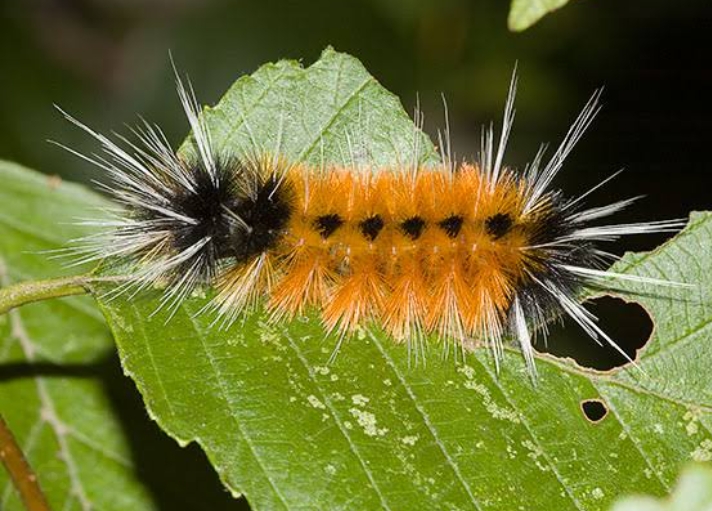
The Yellow-Spotted Tussock Moth Caterpillar has a striking appearance with tufts of bristle-like hairs covering its body. These hairs are black at the base, white in the middle, and yellow at the tips.
There are typically four large, bright yellow tufts of hairs near the front of the caterpillar’s body, which give it its “yellow-spotted” name.
In addition to the yellow hairs, this caterpillar may have a few white or orange spots scattered along its body, especially toward the rear. These caterpillars can reach a length of about 4 to 5 cm.
Common host plants include oak, willow, maple, and cherry trees. They are not picky eaters and may consume any type of vegetation.
Yellow-Spotted Tussock Moth Caterpillars are generally not aggressive and do not exhibit social behavior like some other caterpillar species. They are solitary feeders and often go about their business independently.
The caterpillar’s primary defense mechanism is its bristle-like hairs. These hairs can cause skin irritation or cause allergic reactions in some individuals if touched.
The adult Yellow-Spotted Tussock Moth emerges from the pupal stage. Adult moths are usually brownish-gray with intricate patterns on their wings. They have a relatively short lifespan.
Yellow-Spotted Tussock Moth Caterpillars are native to North America and can be found in habitats such as deciduous forests, meadows and gardens. Their distribution covers much of the eastern and central United States and parts of Canada.
Yellow Spotted Tussock Moth Caterpillar Facts & Identification
The contrast of striking bright yellow hairs and tufts of pitch-black hairs are identifying features of spotted tussock moth caterpillars.
| Scientific Name | Lophocampa maculata |
| Size | About 4 cm |
| Family | Erebidae (formerly part of the Arctiidae family) |
| Distribution | Eastern North America |
| Predators | sparrows, warblers, chickadees, Bats mice and shrews |
| Appearance | late summer and early Autumn |
Cloudless Sulfur Caterpillar (Phoebis sennae)
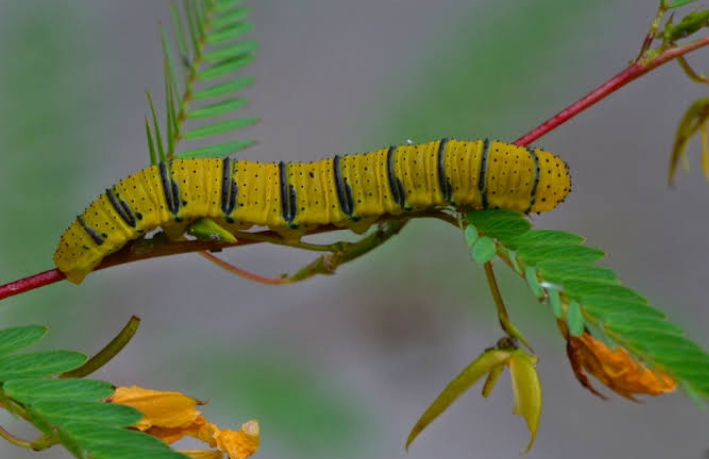
The cloudless sulfur caterpillar is a smooth-bodied yellow caterpillar that does not have any hairs. As the larvae grow, they may become a deeper yellow color, and some may even appear greenish. The caterpillars are relatively large, growing up to 2 inches (5 centimeters) in length.
Cloudless Sulfur Caterpillars can be found in habitats like open fields, gardens, meadows, and disturbed areas. They are most commonly seen in areas with their preferred host plants, which include various members of the Cassia and Senna plant genera.
The caterpillars are often considered elusive pests, because they turn green when eating green leaves and turn yellow when eating yellow flowers. They are usually nocturnal, building their own tents in the host plants to spend the day inside.
The caterpillar undergoes metamorphosis, creating a chrysalis characterized by pointed ends and a humped middle. This chrysalis can have a yellow or green coloration with stripes in either pink or green.
As the transformation completes, a medium-sized butterfly with wings that are moderately elongated but not sharply angled emerges, measuring approximately 2-3 inches wingspan.
These caterpillars can be found across the area extending from southern Canada, including southwestern Ontario, down to South America. They are most abundant in areas spanning from Argentina to southern Texas, Georgia, and Florida.
Cloudless Sulfur Caterpillar Facts & Identification
Bright yellow colors and thin green or dark stripes help identify this nocturnal caterpillar.
| Scientific Name | Phoebis sennae |
| Size | About 5 cm |
| Family | Pieridae |
| Distribution | North America |
| Predators | Sparrows, warblers and finches, mantises, ladybugs, and parasitic wasps |
| Appearance | Late summer and early Autumn |
Six-Spot Burnet (Zygaena filipendulae)

Six-spot Burnet caterpillar has a plump or chubby shaped body. The body is predominantly black with bright yellow or orange transverse bands or spots running along their segments. The specific pattern and intensity of these markings can be different among individual caterpillars. Also, short, bristle-like hairs cover their body.
Six-spot burnet caterpillars feeds on species of legumes, such as bird’s-foot trefoil (Lotus corniculatus), clovers (Trifolium spp.) and vetches (Vicia spp.). These caterpillars are usually associated with grasslands, meadows and other open habitats where their host plants grow.
These caterpillars are toxic to many predators due to the presence of cyanogenic compounds in their bodies, which are derived from their host plants. When threatened, they release these toxins, making them unpalatable to potential predators.
This caterpillar is a common species throughout Europe, except the Atlantic coast of the Iberian Peninsula, northern Scandinavia and the Great Russian North. It is also present in Asia Minor, through the Caucasus to Syria and Lebanon
Six-Spot Burnet Caterpillar Facts & Identification
The identification features of the six-spotted burnet caterpillar are its bright yellow body, black markings along its back, a light green stripe on its sides and thin spiny hairs.
| Scientific Name | Zygaena filipendulae |
| Size | About 4 cm |
| Family | Zygaenidae |
| Distribution | North America, Europe and middle east |
| Predators | Cuckoo, Tarantula |
| Appearance | Late summer and early Autumn |
Tasar Silkworm Caterpillar (Antheraea mylitta)
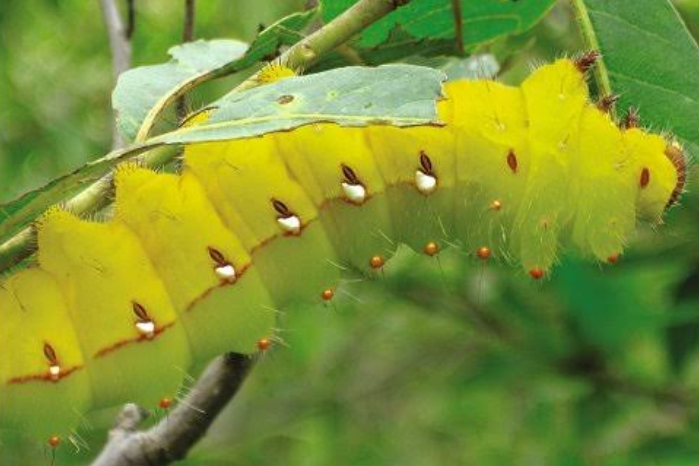
The Tasar silkworm caterpillar is a species of silk-producing caterpillar native to India and some other parts of Southeast Asia. Tasar silk is one of the several types of silk produced by different species of silkworms.
Tasar silkworm larvae are voracious feeders. They primarily feed on the leaves of certain host trees, including species from the Terminalia and Shorea genera. These caterpillars have strong mandibles that they use to chew and consume the leaves. As they eat, they go through a rapid growth phase, increasing in size significantly.
Like other caterpillars, Tasar silkworm caterpillars grow through a process called molting. They shed their exoskeleton periodically as they outgrow it. Each molt marks a new instar (developmental stage). The number of instars can vary, but typically, there are five or six instars before the caterpillar is ready to spin its cocoon.
After the fat caterpillar emerges from its metamorphosis, it is a stunning type of moth. The silkworm moth has orange or brown wings with a white eye-like dot on each wing.
Tasar silkworm caterpillar Facts & Identification
| Scientific Name | Zygaena filipendulae |
| Size | About 4 cm |
| Family | Zygaenidae |
| Distribution | North America, Europe and middle east |
| Predators | Cuckoo, Tarantula |
| Appearance | Late summer and early Autumn |
Pale Tussock caterpillar (Calliteara pudibunda)
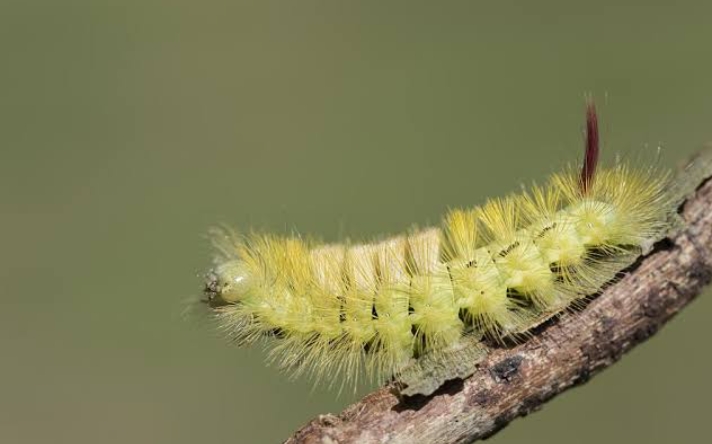
The Pale Tussock caterpillar is found in many parts of Europe and Asia. This caterpillar has a cylindrical body divided into several segments, each of which bears tufts of long, pale yellow or greenish-yellow hairs. These hairs are soft and give the caterpillar a fuzzy, hairy, and somewhat whimsical appearance.
On the sides of its body, you can often see a series of black or dark brown spots along with a distinctive row of four, bright yellow or orange tufts of hairs (tussocks) on its back. These tussocks give the caterpillar its name.
When fully grown, the Pale Tussock caterpillar can reach a length of about 4-5 centimeters.
The Pale Tussock caterpillar primarily feeds on deciduous trees and shrubs, including oak, birch, and willow. During this stage, they go through several molts, shedding their old exoskeleton to accommodate their growing body.
The long, hair-like structures covering its body are not only a visual deterrent but also a physical defense. These hairs can be irritating to touch and may cause skin irritation in humans and discomfort to potential predators.
The Pale Tussock caterpillar is typically a solitary feeder. However, you may encounter multiple caterpillars of the same species in the same habitat, but they tend to feed independently of one another.
Pale Tussock caterpillar Facts & Identification
The main identifying feature of the pale tussock is clumps of bright yellow hairs.
| Scientific Name | Calliteara pudibunda |
| Size | About 4-5 cm |
| Family | Erebidae |
| Distribution | Europe and Asia |
| Predators | Finches, warblers, frogs, toads, lizards, mice and shrews |
| Appearance | Late summer and early Autumn |
The Giant Peacock Moth Caterpillar
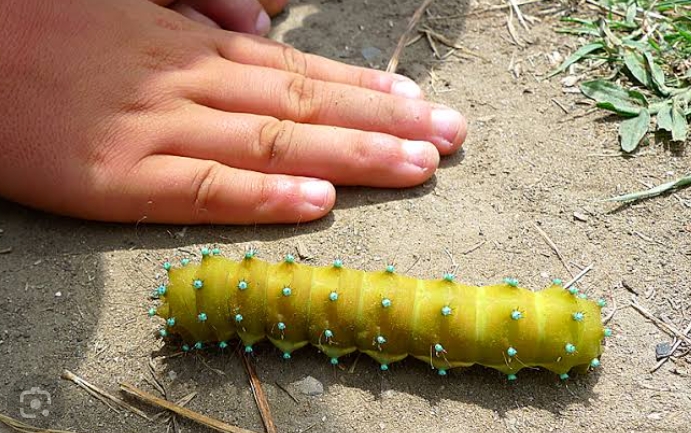
The Giant Peacock Moth Caterpillar is one of the largest and most striking caterpillars found in Europe, Africa and parts of Asia. It grows up to 15 centimeters (about 6 inches) in length. The body is covered in short, fine hairs, giving it a somewhat fuzzy appearance.
The body is usually bright green or yellow-green and body covered in small, warty protuberances, which can have blue or turquoise spots. These spots give it a peacock-like appearance, hence the name “peacock moth.”
The caterpillar hatches from the egg and goes through several instars, growing larger with each molt. During this stage, it feeds voraciously on the leaves of its host plant.
When they emerge as brown moths, they are the biggest species of moth in Europe. Their wingspan is a massive 6” to 8” (15 – 20 cm). Their dark gray to brown wings has large eye markings. Adult moths are mostly nocturnal.
Giant Peacock Moth caterpillar Facts & Identification
They are primarily green, with lateral lines of vivid blue or turquoise running along each side of their body. These lines are dotted with small, black spots. The body is covered in fine, short hairs.
| Scientific Name | Saturnia pyri |
| Size | About 15 cm |
| Family | Saturniidae |
| Distribution | Europe and Asia |
| Predators | Finches, warblers, frogs, toads, lizards, mice and shrews |
| Appearance | Late summer and early Autumn |
Yellow Fuzzy Spotted Apatelodes (Apatelodes torrefacta)
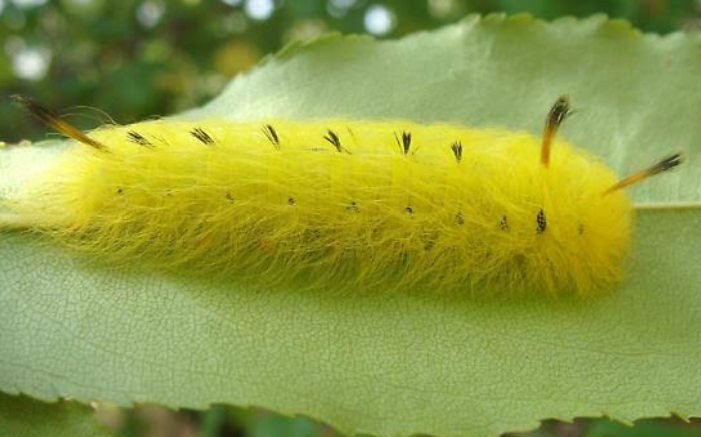
The caterpillar of the Yellow Fuzzy Spotted Apatelodes is covered in long, dense and wispy yellow or orange-yellow hairs, which give it a notably fuzzy and woolly appearance. They are often described as “hairy” or “furry.”
Some caterpillars may have black spots or markings on their body and these spots can be variable in size and distribution. Generally, Younger ones are white, but the older ones are neon yellow.
When fully grown, the Yellow Fuzzy Spotted Apatelodes caterpillar typically reaches a length of about 2 to 3 inches (5 to 7.5 centimeters).
Like many caterpillars, they are herbivorous and primarily feed on the leaves of various trees and shrubs. Their choice of host plants may vary depending on their geographic location.
After undergoing their larval (caterpillar) stage, Apatelodes torrefacta caterpillars will pupate and eventually emerge as adult moths. The adult moths are typically brown in color and have a more subdued appearance compared to the caterpillars.
These caterpillars are found in different regions of North America, including the eastern United States and parts of Canada.
Yellow Fuzzy Spotted Apatelodes caterpillar Facts & Identification
Caterpillars are completely covered in wisps of hairs. Younger ones are white, but the older ones are neon yellow.
| Scientific Name | Saturnia pyri |
| Size | About 15 cm |
| Family | Saturniidae |
| Distribution | Europe and Asia |
| Predators | Finches, warblers, frogs, toads, lizards, mice and shrews |
| Appearance | Late summer and early Autumn |
Silver-Spotted Skipper Caterpillar (Epargyreus clarus)
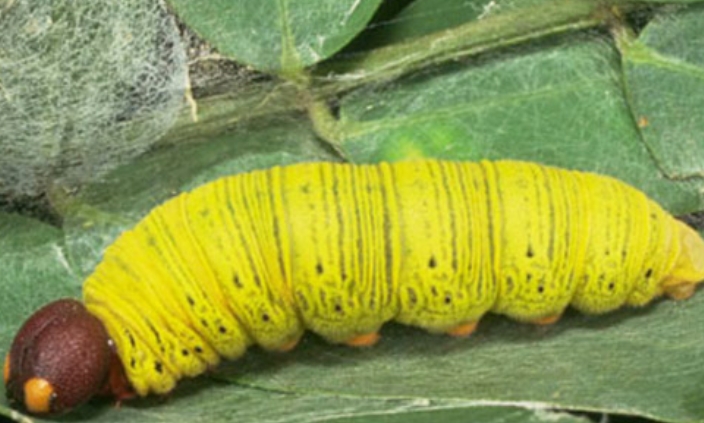
This caterpillar unique in appearance. It is primarily green, with cream-colored band running along their sides. This band is often interrupted by a series of dark green or black spots. The head capsule of this caterpillar is brown, and it features two widely spaced black eyespots on the sides.
The caterpillar of the Silver-Spotted Skipper is relatively small, typically measuring between 1 to 1.5 inches (2.5 to 3.8 cm) in length.
When it’s ready to undergo metamorphosis, the caterpillar forms a chrysalis (pupa) by attaching itself to a suitable surface, often a plant stem or leaf. Inside the chrysalis, the caterpillar undergoes a remarkable transformation into an adult butterfly.
The stout yellow caterpillars feed on various legume plants in the pea family Fabaceae, black locust trees, and wisteria plants. The yellowish caterpillars are poisonous to other insects, birds, and small animals that try to eat them. They produce a bitter-tasting, greenish liquid when disturbed.
Silver-Spotted Skipper Caterpillars can be found in different habitats across North America, including meadows, open woodlands, gardens, and grassy fields. They are most commonly observed in the eastern and central parts of the United States, ranging from the Great Plains to the Atlantic Coast.
Silver-Spotted Skipper caterpillar Facts & Identification
They are primarily green, with a distinctive cream-colored band running along their sides. This band is often interrupted by a series of dark green or black spots.
| Scientific Name | Epargyreus clarus |
| Size | About 3.5 cm |
| Family | Hesperiidae |
| Distribution | North Africa |
| Predators | Finches, warblers, frogs, toads, lizards, mice and shrews |
| Appearance | Late summer and early Autumn |
Cinnabar Moth Caterpillar (Tyria jacobaeae)
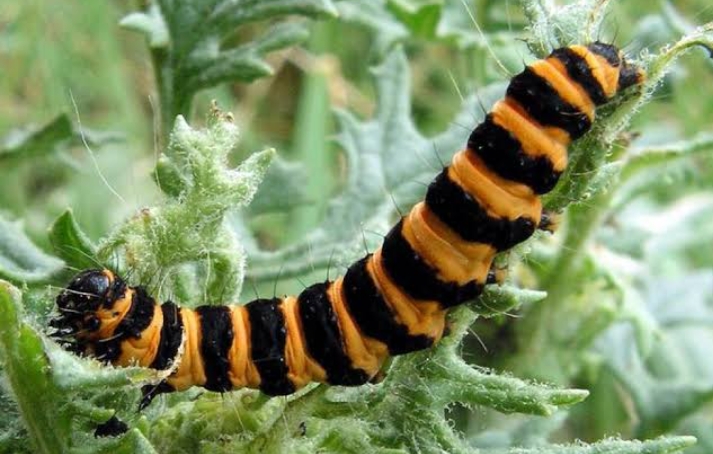
The Cinnabar Moth Caterpillar is easily recognizable. Its body is predominantly black with vivid orange-red bands running along its sides. These caterpillars typically grow to a length of about 3-4 centimeters. They are particularly common in regions of Europe and Asia, including the United Kingdom, where they are often encountered.
After hatching, the caterpillars feed voraciously on the leaves of the ragwort plant. They accumulate toxins from the plant, making them unpalatable to many predators. Also, the. the bold orange-red bands on their body serve as a warning signal to potential predators, a phenomenon known as aposematism.
When the caterpillar reaches maturity, it seeks a sheltered location to pupate. During this stage, it undergoes metamorphosis and transforms into a pupa, encased in a cocoon-like structure.
After a few weeks in the pupal stage, the adult Cinnabar Moth emerges from the cocoon. The adult moths have striking red and black wings, and they are active during the summer months. They are primarily nocturnal and are attracted to light.
Cinnabar Moth caterpillar Facts & Identification
Its body is predominantly black with vivid orange-red bands running along its sides.
| Scientific Name | Tyria jacobaeae |
| Size | About 4 cm |
| Family | Erebidae |
| Distribution | Africa, Europe, Asia |
| Predators | orb-weaving spiders, the wasp |
| Appearance | Late summer and early Autumn |
Grapeleaf Skeletonizer Caterpillar (Harrisina americana)

The Grapeleaf Skeletonizer Caterpillar is primarily found in North America, including the United States and Mexico. This caterpillar has a unique feeding habit. It feeds by scraping away the leaf tissue between the veins, leaving behind a skeletonized appearance.
The caterpillar of Harrisina americana is small, about 1 inch (2.5 cm) long. It has a bright green or yellow-green color, a series of lateral white stripes along its body and numerous spiky protrusions or tubercles. It has hair-like setae that, if brushed against, will give a rash that lasts several days.
While the name suggests a preference for grapevines, Grapeleaf Skeletonizer Caterpillars can also be found on other plants, including Virginia creeper, Virginia creeper, and various fruit trees. They are considered pests in vineyards and gardens. They constantly live on the underside of the leaves, and frequently line up side by side.
In many regions where these caterpillars are found, they tend to be more active during the warmer months of the year, typically from late spring through early fall.
Grapeleaf Skeletonizer Caterpillar Facts & Identification
To identify the grape leaf skeletonizer, look for its bright yellow body and bands of black spots around each of its segments.
| Scientific Name | Harrisina americana |
| Size | About 3 cm |
| Family | Zygaenidae (Burnet and Forester Moths) |
| Distribution | North America and Mexico |
| Predators | Praying mantises, braconid wasp, ladybird beetles, sparrows, warblers and wrens |
| Appearance | Summer and early Autumn |
Redhumped Caterpillar (Schizura concinna)
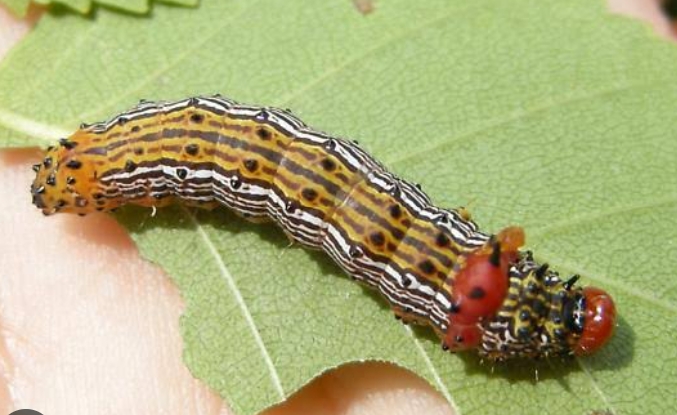
The redhumped caterpillar, Schizura concinna (Notodontidae) is native to North America and can be found throughout the eastern and central regions of the continent.
It is found throughout much of the United States. In California, high populations are usually limited to the Central Valley. This pest most commonly chews leaves of liquidambar (sweet gum), plum and walnut. It also feeds on almond, apple, apricot, birch, cherry, cottonwood, pear, prune, redbud, willow, and other deciduous trees and shrubs.
Newly hatched (first-instar) caterpillars are approximately 1⁄8 inch long and often feed in groups. Young larvae have dark brown to black heads, yellowish-orange bodies with faint dark, lengthwise stripes, and rows of dark bumps (tubercles) with bristles along the body.
Adult caterpillar has a lime-green body with a prominent, reddish-brown hump located on the third thoracic segment. It measures around 1 to 2 inches (2.5 to 5 cm) in length.
Like all caterpillars, Redhumped Caterpillars have segmented bodies with three pairs of true legs near the head and several pairs of prolegs along the abdomen, which help them move and grip plant surfaces.
After reaching maturity, the caterpillar pupates by forming a cocoon or sheltered pupation site, often using leaves or silk threads. Inside the pupa, the caterpillar undergoes metamorphosis and transforms into an adult moth, which has brownish-gray wings with some markings and a wingspan of around 1 to 1.5 inches (2.5 to 3.8 cm).
Redhumped Caterpillar Facts & Identification
The yellow redhumped caterpillar can be identified by its black and white bands running the length of its body, black fleshy spines, a red head, and conspicuous red humps near its head.
| Scientific Name | Schizura concinna |
| Size | About 2.5 to 5 cm |
| Family | Notodontidae |
| Distribution | North America |
| Predators | Ants, wasps and beetles, orb-weaving spiders and garden spiders, frogs and toads, and reptiles, like lizards. |
| Appearance | Early summer and early Autumn |
Large Cabbage White Caterpillar (Pieris brassicae)

The Large Cabbage White Caterpillar is a common species of butterfly larva found in many parts of Europe and Asia. It is a member of the family Pieridae, which includes various white and yellow butterflies commonly referred to as “whites.”
When fully grown, it can reach a length of approximately 4-5 centimeters (1.5-2 inches). It has a velvety yellowish-green body with a series of black markings along its sides and back. The head is black or dark brown. On each body segment, there are small, bristle-like structures or setae.
Large Cabbage White Caterpillars are commonly found in gardens, farmlands, meadows and open woodlands. They are feed on cultivated brassica plants especially cabbage, broccoli, cauliflower and Brussels sprouts.
In agriculture, this caterpillar is considered a pest, because it causes significant damage to agricultural crops if present in large numbers.
After the caterpillar completes its growth, it undergoes metamorphosis and transforms into a pupa, which is green or brown and is usually suspended from a silk thread.
Large Cabbage White Caterpillar Facts & Identification
The large cabbage white butterfly caterpillar is identified by its yellowish-green body, irregular black spots, black head, and covering of white spiny setae.
| Scientific Name | Pieris brassicae |
| Size | 4-5 centimeters (1.5-2 inches) |
| Family | Pieridae |
| Distribution | Europe, Africa and Asia |
| Predators | birds, spiders and parasitic wasps. |
| Appearance | Early summer and early Autumn |
Magpie Moth Caterpillar (Abraxas grossulariata)
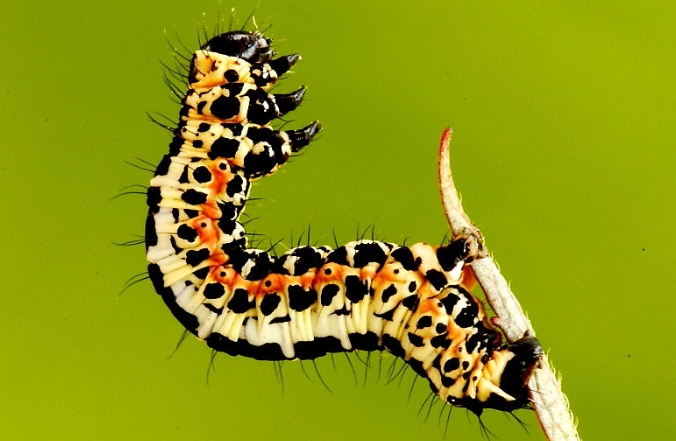
The Magpie Moth Caterpillar is an easily recognizable caterpillar species found in Africa, North America, parts of Europe, Asia and South America. It belongs to the family Geometridae, which includes moth species commonly known as “geometer moths” due to the caterpillar’s unique looping or inching movement.
The magpie moth caterpillar is black with bold, contrasting cream or yellow markings. These markings resemble the pattern of a magpie bird, which is how the caterpillar got its common name. It has a cylindrical body with three pairs of true legs at the front and several pairs of fleshy, prolegs towards the rear.
The caterpillar reaches a length of around 4-5 centimeters (1.5-2 inches) when fully grown. It is commonly found in gardens, woodlands, heathlands and meadows, throughout its range. The caterpillar is usually active between April and September.
After a period of time, the adult Magpie Moth emerges from the pupal stage. The adult moths usually have beautiful black-and-white or black-and-yellow patterns on their wings resembling the markings of the caterpillar.
Magpie Moth Caterpillar Facts & Identification
The striking magpie moth caterpillar is identified by its creamy yellowish-white body, rows of black and white dots in irregular patterns, and orange stripes along its sides.
| Scientific Name | Abraxas grossulariata |
| Size | 4-5 centimeters (1.5-2 inches) |
| Family | Geometridae |
| Distribution | Africa, North America, parts of Europe, Asia and South America |
| Predators | Lizards, Parasitoid wasps, flies, predatory beetles |
| Appearance | April and September |
White-Lined Sphinx Moth Caterpillar (Hyles lineata)

The White-Lined Sphinx Moth Caterpillar species is found primarily in North and Central America. It is slug-like insect with a yellowish-green to dark yellow body and two prominent lengthwise black stripes. This caterpillar can grow up to 3 to 4 inches (7.5 to 10 cm) in length. It can also sometimes be lime green and black.
These caterpillars have a distinctive yellow-orange horn-like structure at the rear end, often referred to as a “tail horn.”
They are known to migrate from place to place based on food availability and environmental conditions. They feed on plants such as evening primrose, grapevine, tomato, and various members of the Solanaceae family. They feed extensively and can be seen munching on leaves.
While their horn may resemble stinging caterpillars, White-Lined Sphinx Moth Caterpillars are not equipped with venomous stingers. Instead, they rely on their cryptic coloration and the horn’s appearance to deter potential predators.
When the caterpillar reaches maturity, it burrows into the soil to pupate. In some cases, they may pupate in a shallow underground chamber. The pupa eventually transforms into an adult moth.
The White-Lined Sphinx Moth is known for its rapid flight and its ability to hover, similar to a hummingbird, while feeding on nectar from flowers. They are nocturnal and are attracted to bright lights at night.
White-Lined Sphinx Moth Caterpillar Facts & Identification
The white-lined sphinx moth caterpillar is identified by a yellowish-green slender body, black stripes along its back, an orange or pale brown tail, and brown and black markings along its sides.
| Scientific Name | Hyles lineata |
| Size | 3 to 4 inches (7.5 to 10 cm) |
| Family | Sphingidae |
| Distribution | North and Central America |
| Predators | Praying mantises, warblers and robins |
| Appearance | May and September |
Grass Eggar Moth Caterpillar (Lasiocampa trifolii)
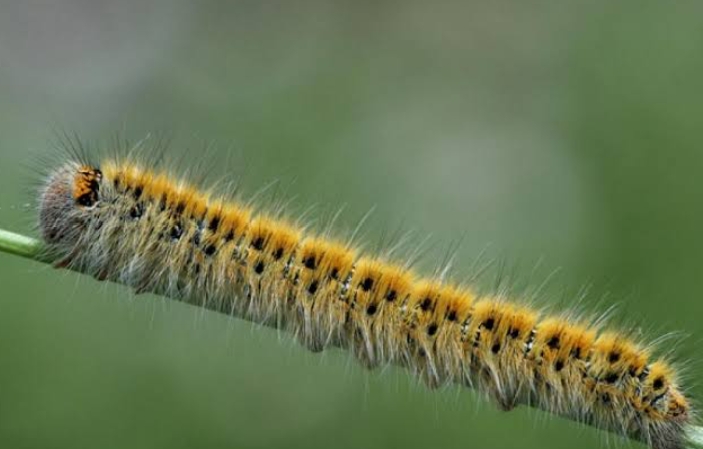
The caterpillar of the Grass Eggar Moth measures around 5-6 centimeters in length. Its body is covered in dense and long hairs, which give it a furry appearance. The color of these hairs is usually yellowish but sometimes with pale-yellow, orange-brown or gray. They have ability to blend in with the surrounding vegetation
Grass Eggar Moth Caterpillars may not be as well-known as some other caterpillar species but are usually found in grassy habitats and majorly feed on various grasses and low-growing plants.
The caterpillars can be seen during the warmer months of late spring through summer, which roughly spans from May to August in many parts of its distribution range.
Grass Eggar Moth Caterpillar Facts & Identification
The grass eggar caterpillar is identified by its dense covering of fine hairs on its black body. The color of these hairs is usually yellowish.
| Scientific Name | Lasiocampa trifolii |
| Size | 5-6 centimeters |
| Family | Lasiocampidae |
| Distribution | Europe, Mediterranean region, Africa |
| Predators | Praying mantises, warblers and robins |
| Appearance | May and August |
African Death’s-Head Hawkmoth (Acherontia Atropos)

Image Credit: Craig Rogers Photography
The African death’s-head hawkmoth larva is a giant bright yellow caterpillar that looks like a yellow tobacco hornworm. These caterpillars are notable for their unique appearance and behaviors. They are found in many parts of sub-Saharan Africa (from east, west and south Africa). They inhabit forests, savannas and urban areas.
They reach lengths of 4 to 5 inches (10 to 13 cm). Their body is covered in fine, short hairs. The body features shades of green and brown with longitudinal stripes running along their body.
African Death’s-Head Hawkmoth caterpillars primarily feed on the leaves and foliage of plants, especially those from the Solanaceae family. This includes plants like potatoes, tomatoes, and bell peppers.
One of the most notable behaviors is their ability to produce a loud, hissing sound by forcibly expelling air through spiracles when threatened. They may also regurgitate a noxious liquid as a further deterrent.
After pupating, the enormous yellow larva turns into a stunning brown and yellow moth. It gets its name from the skull-shaped pattern near the moth’s head.
African Death’s-Head Hawkmoth Caterpillar Facts & Identification
It is easy to identify due to its bright enormous yellow body, diagonal grayish stripes and spotted back.
| Scientific Name | Acherontia atropos |
| Size | 4 to 5 inches (10 to 13 cm) |
| Family | Sphingidae |
| Distribution | Sub-Sahara Africa |
| Predators | raccoons and opossums |
| Appearance | January, February, May & September |